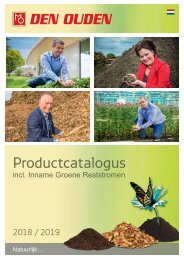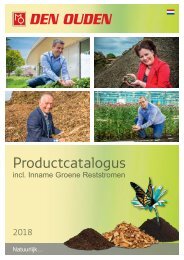Business Presentation Den Ouden Groep 03-2018
Create successful ePaper yourself
Turn your PDF publications into a flip-book with our unique Google optimized e-Paper software.
2. What do we offer?<br />
References<br />
Historical research UXO transport systems<br />
and sewer pumping stations north<br />
Client:<br />
Kragten<br />
Implementation period: 2017<br />
Nordstream 2: PUXO 2X submarine pipelines<br />
and onshore facilities - Baltic Sea<br />
Client:<br />
NSea<br />
Implementation period: 2017<br />
The historical research for the Transport Systems and<br />
Sewer Pumping Stations North project involved five subareas<br />
in the Betuwe, where Waterschap Rivierenland will<br />
carry out work on a number of sewage treatment plants.<br />
The total length of the grids is 20 km.<br />
The historical research focused on the extent to which the<br />
project area was involved in war operations in the 1940-<br />
1945 period. The Betuwe was one of the most affected<br />
areas during World War II. Ochten, Opheusden, and Zetten,<br />
among other places, were so heavily damaged that after<br />
the liberation, residents had to wait several months before<br />
they could return. The Betuwe was on the front line from<br />
September 1944 until the end of the war in May 1945.<br />
In addition to these war operations, the Betuwe was also<br />
under water for a long time: the Germans blew up the<br />
Rijndijk in early December 1944, which flooded the area<br />
between Tiel and Elst. The water not only drove Allied and<br />
German troops out of the area, but also erased many war<br />
traces such as craters. This made it difficult to interpret<br />
the aerial photographs from 1945.<br />
The Nordstream 2 project consists of two undersea<br />
pipelines with a diameter of 1,20 meters. The pipelines<br />
and attached onshore facilities cross through most of the<br />
Baltic Sea, from the Russian coast to the German coast.<br />
Throughout history the Baltic Sea has been the theatre of<br />
naval warfare. As a result of this fighting, many remnants<br />
of unexploaded ordnance (UXO) are still present in the<br />
seabed. Examples are mines, bombs from airplanes and<br />
torpedo’s. There are also several dump sites for munitions<br />
present in the Baltic Sea. One of these, near the island<br />
Bornholm, was used as a dumping ground for both regular<br />
and chemical munitions. These historical events, as well<br />
as present day military practice areas, make it necessary<br />
to conduct UXO surveys in the Baltic Sea. BODAC scanned<br />
the seabed with multibeam echo sonar (MBES), side-scan<br />
sonar (SSS), magnetometer and gradiometer equipment.<br />
The data was then analysed to provide a clear picture of<br />
unexploaded ordnance still present in the seabed. When<br />
necessary BODAC removed dangerous objects along the<br />
sea-corridor.<br />
31
















